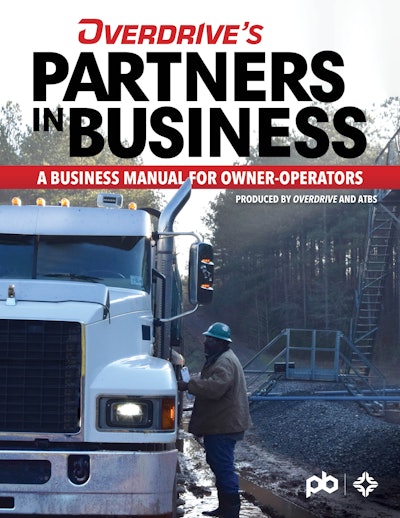Most trucking safety rules are found in Title 49 of the Code of Federal Regulations, containing the Federal Motor Carrier Safety Regulations. Owner-operators must keep a copy of the regulations in their trucks. Many truck stops sell inexpensive paperback copies of them, and they’re also available online and in digital form via FMCSA.dot.gov.
The parts that most affect owner-operators:
- Part 390. General overview: violations and penalties.
- Part 391. Driver qualifications: responsibilities, annual review, records, road tests.
- Part 392. Driving commercial motor vehicles: safe loading and fueling practices, safety at railroad crossings, seatbelt use, emergency signals, emergency equipment use, passengers, illness and fatigue, drug and alcohol use.
- Part 393. Parts and accessories: proper lights and reflectors, wiring, batteries, brakes, windows, fuel systems, coupling devices, towing methods, tires, sleeper berths, mirrors, defrosters, speedometers, exhaust systems, floors, rear-impact guards, frames, cabs, suspensions, steering systems.
- Part 395. Hours of service: maximum driving time and on-duty time, record of duty status, electronic logging devices, out-of-service declarations.
- Part 396. Inspection, repair and maintenance, including recordkeeping requirements.
- Part 397. Transporting hazardous materials, state and local laws, driver presence and surveillance, parking, fires, smoking, fueling, tires and routing.
In 2010, the Federal Motor Carrier Safety Administration began implementing its Compliance, Safety, Accountability program. It features a safety scoring system for motor carriers, including independent owner-operators, based on roadside inspection observations and crash data. After limitations of the program became readily obvious to trucking and government alike, Congress in the FAST Act highway bill in 2015 required FMCSA to remove CSA scores in the program's Behavioral Analysis and Safety Improvement Categories from public view until reforms were made to the system.
Significant reforms have been a long time in coming, though at least some changes as of this writing are under way. And: Category scores for every carrier in the nation remain available for viewing by law enforcement, and motor carriers themselves. The general public, insurers and shipper/broker customers still can access raw inspection and violation data via the CSA website for any carrier going back two years. After the scores were pulled from public view, too, about a third of Overdrive readers still reported a third party (such as a broker, shipper or insurance company) retained visibility into their now-private scores, whether requesting them directly or using a subscription service to compute carriers’ scores as if nothing changed at all about their public availability.

In essence, the cat is long out of the bag on safety scoring.
 This feature is part of Overdrive's coproduction with business services firm ATBS of the Partners in Business manual, a comprehensive playbook for owner-operator careers. Browse the 2025 edition in its new dynamic online library format in eight sections via this link.
This feature is part of Overdrive's coproduction with business services firm ATBS of the Partners in Business manual, a comprehensive playbook for owner-operator careers. Browse the 2025 edition in its new dynamic online library format in eight sections via this link.
You can minimize the impact of CSA by being certain your truck is in compliance with all equipment regulations and by following these steps:
Do everything practical to avoid violations during inspections. That starts with thorough pre-trip and post-trip inspections and attention to needed maintenance, and extends to minimizing inspections themselves. Some carriers have instituted cash awards to operators for clean inspections, with no violations, which help a carrier’s CSA rankings, so this could pay extra dividends. Use PrePass or other weigh-station bypass systems to stay out of the inspection stations as much as possible. Wash your truck regularly, dress neatly and otherwise avoid doing anything that might draw the attention of patrol officers. Safety and compliance consultants urge their small-fleet clients to run their lights at all times. The practice gives operators a better chance to observe, and fix, lamps that have burned out or otherwise malfunctioned. Easily seen light violations are known to be a big trigger for an inspection that then uncovers more problems.
Highway patrolmen note that up to 90% of every carrier’s problems arise from speeding. Slowing down will help your carrier’s or your own ranking, because if you speed and are caught, the officer often will inspect your vehicle, and small violations can mount up.
Clean inspections are the only immediate way to improve categorical percentile rankings in CSA’s Safety Measurement System. A clean Level I driver and truck inspection improves carrier scores in most CSA SMS categories of compliance measurement by offsetting or diluting the weight of prior violations.
Inspection likelihood around the nation changes slightly year to year. Overdrive's last update with calendar-year 2022 (shown below) showed just where the inspections are most likely. Don't let an active commercial-vehicle enforcement unit be just a reason to avoid a state, though. Those clean, violation-free inspections will help your record and reputation.
Protect your Motor Vehicle Record. If you get a ticket you believe is unjustified, whether following a crash incident or other violation on the road or at a scale house, know that payment of the fine is an admission of guilt. It ensures that the ticket becomes a conviction and will follow you through at least the next few years of your career -- and in some states, much longer -- on your Motor Vehicle Record.
Employers are required to keep on file an annual MVR for every CDL driver they employ. Depending on the carrier, one or more convictions for serious violations could be grounds for terminating a lease.The MVR is also a prime determining factor in insurance rates for all owner-operators, especially impactful for independent with authority in their commercial auto liability rates.
If you think you’ve been ticketed wrongly, you can either represent yourself in traffic court or hire legal representation. Some services such as the Drivers Legal Plan represent truckers for generally small fees.
Pick your partners wisely. A carrier that takes its safety scoring seriously is going to be increasingly more likely to have solid customers and its pick of freight than the opposite. Treat your carrier as a partner in your business, and look for them to treat you the same way.
Stay on top of your electronic logging device. ELDs can eliminate the majority of what used to be common “form and manner” hours of service violations. Hours of service is one of seven categories in the CSA scoring system. Yet ELDs, by virtue of their partially automated, detailed recordkeeping, can create new compliance problems in difficult situations, such as when you are unable to find a place to park or need to move your truck a short distance during an off-duty period. Be sure to stay current with regulators’ interpretations of personal conveyance guidelines and, if you’re leased, your carrier’s policy regarding ELD annotations and editing.
You should also try to stay current with any changes made to the hours of service regulations themselves. In 2020, FMCSA instituted some changes that included expanding the allowable split sleeper provisions, changing the rules around the 30-minute break and more. For more details on those changes, listen to the following Overdrive Radio podcast episode with FMCSA from the time:
Consider using video systems. A forward-facing video camera can prove a driver’s innocence after an accident and other events. Such evidence can be key in making challenges to erroneous violations and in some instances contesting tickets to protect your MVR. Some fleets are using driver-facing cameras not only to determine the possible cause of an accident but also as an ongoing training tool. Such systems usually are offered as opt-ins for leased owner-operators.
Mind the small stuff. Pay strict attention to all aspects of your operation. A frequently incurred violation contributing to scores in the Unsafe Driving category is the simple seatbelt violation, often accrued after a speeding stop.
Build law enforcement relationships. For independents, good relationships with the highway patrol in your area will enable you to call on them for advice in particular situations. It also will increase the possibility that, should you need help in the Vehicle Maintenance CSA category, they might make themselves available for so-called "terminal inspections," conducted at your central place of business.
Managing the historical inspection information that is being collected about you also is important.
Access your records. In the view of FMCSA, any owner-operator who is leased to a carrier and hasn’t had his authority for the last two years does not have any safety ranking in the CSA system. But a leased owner-operator’s data profile there is important. Leased owner-operators can gain access to the data the internal measurement is based on via FMCSA’s Pre- Employment Screening Program, or PSP for $10.
Alternatively, making a Privacy Act request via FMCSA’s Freedom of Information Act office will net you the same results for free -- but with a turnaround time of weeks. If you have a prior driving and inspection history and haven’t accessed the information, it’s important to do so to make certain it is correct. It will be used by carriers evaluating any lease application you make, and it could impact your insurance rates.
For owner-operators applying for a new lease and facing carrier qualifying processes, a pristine PSP report is valuable, as some carriers look to tie driver mileage or percentage pay scales to safety performance. Whether you’re leased or independent, you’ll be reviewing information contained within the same database. Make certain all violations and crashes contained on your PSP, or in your CSA SMS profile if you have your authority, are correct.
Read next: Significant hours of service change: FMCSA's 2020 split-sleeper provision changes, explained












